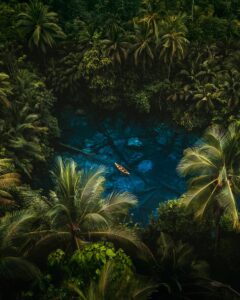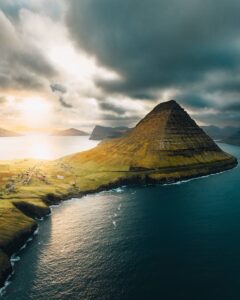
Tom Fähndrich (@tofenpics): Best of the Week 47 at #nomadict
Tom shares the journey behind his winning photography, from a passion for exploration and remote places to field lessons, composition choices, and color grading.
Jidhun, a professional photographer from south India, started capturing landscapes in 2009. Since then, he has evolved greatly, winning international recognition and awards. His distinctive style shines in meticulous drone photography, and his image “Duck Tales” marked a career turning point, showcasing the potential of drone photography.
I hail from the countryside in south India, filled with various landscapes, such as rice fields and hills. My love for traveling started here, where I would roam around the village, spending time in these landscapes. They have never failed to amaze me with how different they look each time, with the lighting, the hue, etc. Movies, wallpapers, and calendar images further ignited this passion.
2009 was the year that I purchased my first camera because I wanted to be able to capture these moments. My camera and I had to explore new landscapes worldwide, finding unique moments to capture. I am very grateful to have been able to do this so that people like the young me could dare to dream.
I have made significant personal and professional progress over the past few years, as artists, experiencing self-doubt and acting as our own harshest critics is quite normal.
It’s essential to take the time to appreciate your personal growth by comparing your work to your past creations rather than constantly measuring yourself against other artists. Additionally, I’ve learned that recognition or results may take time despite passion and hard work. It’s important to persevere and maintain consistency.
Always remember the value of acquiring knowledge from any source.
Above all, remember to take a moment for yourself and continue being true to who you are. I have come to understand the significance of self-care, realizing that neglecting it can impact your overall output.
This image was captured during my first trip to Iceland. I was especially eager to witness the Northern Lights and capture aurora scenes. Having viewed the stunning landscapes captured by renowned photographers, I was determined to avoid replicating similar frames. My goal was to produce something truly unique.
On that particular night, there was aurora activity despite some cloud cover. The hidden moon behind the clouds made it easier to capture decent aurora shots with less foreground light. After taking a few standard frames, I searched for distinctive foreground elements to compose a different shot. However, the chilly weather and dim light were obstacles. Undeterred, I proceeded to the waterfall’s plunge pool and noticed ice crystals swirling in the water—an unexpected framing opportunity.
I realized that lowering the shutter speed could create an eye-catching whirlpool effect. I used the aurora as the backdrop, the mountain as the middle ground, and the “whirlpool” as the foreground, adding depth to the image. After a few test shots, the moon rose above the clouds, lighting the waterfall and enhancing the photo’s magical mood. I exposed the whirlpool for 30 seconds and the aurora for 10 seconds.
The image results from stacking these multiple exposure shots together and carefully post-processing highlights and shadows, adjusting colors, and removing distractions. This approach helped maintain balance and avoid clutter, which is significant in an image with multiple elements. The moonlight illuminating the mountain, waterfall, whirlpool effect, and aurora render this photograph a standout in my portfolio.
Duck Tales is a special image for me. One day, I decided to spend an evening at the nearby backwaters, which used to be a hangout place at the beginning of my photography journey. Since I had never flown a drone there, I decided to try my luck. I didn’t have many expectations, but I was shocked by the view on my controller. A group of ducks was swimming in a line towards the mangrove tree as if seeking shelter. It was an unexpected image. This moment made me realize the potential of drone photography and the endless possibilities for unique frames from a place. The image was widely recognized and became a turning point in my career:
In 2021, I launched a project that captured diverse images from the same locations. I chose spots within my state and did frequent visits. Photographing solely in the same area repeatedly is challenging, as you can imagine. But if you actively seek new framings to overcome this, you will learn something new each session. Surprisingly, some frames from this project were unexpected successes, earning international awards.
Thus, I cannot recommend enough to experiment with lighting and compositions since this makes your aerial shots outstanding. Go beyond top-down shots; experiment with heights, angles, and techniques. I also focus on incorporating subjects, leading lines, and exploring abstract patterns in my work. Google Earth is handy here as it gives you a clear idea of the terrain and cool patterns on the ground.
While drone camera systems may not match mirrorless or DSLR systems’ dynamic range and ISO performance, I solve these limitations by prioritizing good lighting conditions and keeping the ISO low. I also experiment with side light, especially after sunrise or before sunset, for strong shadows, which lend a dynamic look to the scene.
I place a strong emphasis on post-processing as an artist. It sets us apart and defines our unique style, among other things. To show my editing workflow, I have selected a photograph taken in Verstrohorn, Iceland.
1. Destructive beginnings: I blend, warp, and clean to lay the groundwork, with basic adjustments made in Camera Raw.
2. Add depth using contrast: I darken the image, leaving spots of light for a dynamic look.
3. Play with colors: I adjust colors individually and locally for a captivating palette, utilizing selective adjustment tools. I lean towards local adjustments over global ones for fine-tuning. I use a copperish yellow for highlights and a greyish blue for shadows. Most other colors are desaturated to reduce visual distractions in the frame.
4. Set the atmosphere: I enhance the light hitting the peak and the shore. I alter the sky to create the mood I envision for the picture.
5. Dreamy touch: I apply the Orton effect for a soft, dreamlike feel.
6. Sharp and clear: I sharpen details to ensure clarity.
7. Sculpt with light: I use dodge and burn for a 3D effect.
8. Final touches: I make precise tweaks to perfect the image.
Like any artist, photographers should be free to reform and bring their vision to light in an image. I prefer to preserve the natural elements of the capture to maintain its authenticity. I am not against altering the scene, but it should be done carefully to avoid losing balance, and I always ensure the final product justifies the original image.
My style evolved through exposure to many works, films, and scenes. I strive to glean inspiration from the diverse colors of landscapes, skies, waters, and everything in between. My fascination lies in observing nature and seamlessly integrating its essence into my artwork. When I make art, I keep it simple and natural, with bright colors and a strong contrast between light and dark.
In pursuit of a harmonious composition, I work towards achieving contrast in highlights and shadows, with hues of yellow for highlights and tones of blue forming the shadows. While editing, I aim for a subtle glow and a soft aesthetic while ensuring a sharp final output. I make a conscious effort to avoid overexposing whites or employing 100 percent black in my photographs.

Tom shares the journey behind his winning photography, from a passion for exploration and remote places to field lessons, composition choices, and color grading.

Join us in the Faroe Islands for a unique photo tour, where you’ll elevate your creative skills with expert guidance from Ronald Soethje and Nomadict.

Join us in the Azores for a unique photo tour, where you’ll elevate your creative skills with expert guidance from Ronald Soethje, Bruno Ázera, and Nomadict.

In this article, Forest shares how years of chasing scale, silence, and raw landscapes shaped his approach to photography, from the deserts of Kazakhstan to the volcanic ridges of Iceland. He talks about how he uses light, texture, and vast negative space to create images that feel both intimate and overwhelming.

Simon shares the journey behind his photography, from early inspirations to field techniques, editing, and the story of the winning shot that shaped his path.

In this article, Miro shares how his love for cinematic music evolved into a deep passion for photography and how he uses light, color, and atmosphere to turn the streets of Prague into living film scenes.

In this article, Stefanie reveals how her background in physics sparked her passion for astrophotography and how she blends science with creativity to capture the beauty of the night sky. Readers will discover her approach to color, contrast, and editing, as well as her aurora photography workflow.

Spanish photographer Yhabril captures the profound connection between humans and the mountains that shaped him. Growing up in the Pyrenees, his work bridges outdoor sports, landscapes, and celestial scenes — often blending athletes, moonlight, and wilderness into striking visual stories.
